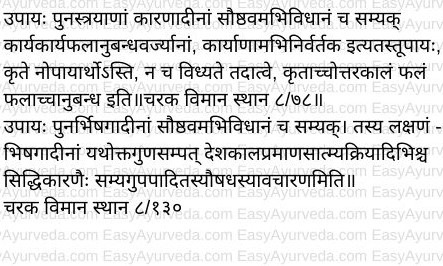Upaya: Examination Of Means Of Action
By Dr Raghuram Y.S. MD (Ay) & Dr Manasa, B.A.M.S
Upaya is ‘means of action or curative measures’. It also means procedure. Upaya is the 10th and final factor to be examined according to Charaka’s ten factors to be examined i.e. dashavidha parikshya bhava.
Read – 10 Factors Of Examination: Dashavidha Parikshya Bhavas

Table of Contents
Definition, Meaning of Upaya
The best qualities of kaarana i.e. physician, karana i.e. medicines and karyayoni i.e. imbalance of doshas in the patient and the association of these three components in such a way that a proper action i.e. treatment is accomplished is called as upaya.
Upaya helps in accomplishing the action. Upaya is of no use once the action has been completed. The role of upaya is only until the action at aim has been accomplished. Upaya is also of no use when the action is in progression. After the action, a treatment process in medical science, has been accomplished it would yield the results. This result is associated with ‘likable or unlikable’ or ‘good or bad’ effects of action.
Read – Chikitsa: Treatment Types, Ayurvedic classification
Components of Upaya
As already said, the physician with good qualities, the medicines adorning best qualities and properties and the evident imbalance of doshas and the association of all three components towards doing an action i.e. setting the imbalanced doshas and body components to balance – are the components of upaya.
The involvement of all these 3 components is mandatory for achieving the necessary action to successful accomplishment.
Imbalance of doshas should be clearly evident with their characteristic signs and symptoms enabling the physician to make a proper diagnosis so as to implement proper treatment. If the dosha imbalance is not clearly evident and cannot be identified, the diseases caused by them too cannot be diagnosed. In such cases the physician cannot progress into the action to balance those doshas. The medicines too will not come into the equation.
The action of the physician and the medicines that he administers is on the dosha imbalance found in the patient which is also the source of action. The physician with good qualities administers medicines with best qualities to set the imbalanced doshas to a state of balance which is also the action taken and everything put together is called as upaya or procedure. This combination will work only at the onset of action. Once the action i.e. treatment process is in progression or when the disease has been cured, the combination of these three components comprising upaya or procedure will not be useful. This is because when the treatment process is in progression it would already have started to balance the imbalanced doshas and when the treatment is completed, the doshas have already come into a state of balance and the person will already be experiencing good health.
This combo is not only the source of action but also forms the procedure of the action i.e. treatment procedure.
Read – Ayurvedic Hospital Management – Chikitsa Chatushpada
Examination of Upaya
There are four limbs of treatment. They are –
Bhishak – physician
Dravya / Aushadha – medicine
Rogi – patient
Paricharaka / Upasthatha – attendant / nursing staff
Just like a table doesn’t stand properly even if one of its 4 limbs has been damaged, the treatment cannot be accomplished to perfection nor can the disease be cured if one of the limbs of the treatment is missing or not involved in the treatment process.
Upaya is when all the four limbs of treatment endowed with all their special qualities getting involved towards the successful accomplishment of treatment (action) and putting all efforts towards the same collectively is called as upaya or procedure. The four components or limbs of the treatment are the means of action as well.
Read – 10 Factors Of Patient Examination – Dasha Vidha Atura Pareeksha
Qualities and examination of upaya
Each of the four limbs of treatment should be endowed with their special qualities. Each of these limbs should be examined thoroughly for the presence of these qualities before starting the upaya or procedure.
The well coordinated limbs of treatment with their optimum qualities should administer best quality medicines prepared with proper classical methods of processing keeping in view –
Desha – the land of the patient or land where the medicine has been grown
Kala – season / part of the day suitable for administering medicines / stages of disease / state of patient
Pramana – dosage of medicines
Satmya – compatibility towards medicines
Kriya – mode of action of the medicines etc
When this is done with the aim of curing the disease by establishing the equilibrium of the doshas, the treatment will be successful.
Read – How To Make Prognosis Of Disease According To Ayurveda?
Sanskrit Verses

Upaya- Research Perspective
When we consider research in place of treatment, the below mentioned factors which help in smooth and proper operation of ‘work plan’ or ‘means of action / procedure of treatment’ shall be included under upaya –
Researcher adorned with excellent qualities
Suitable research methods
Proper selection of research problem
Proper definition of research problem
Formulation of hypothesis
In terms of research,
Kaarana represents the researcher with all his special and significant qualities
Karana represents selection of proper research methods and
Karyayoni represents proper selection and definition of research problem
Click to Consult Dr Raghuram Y.S. MD (Ayu)









